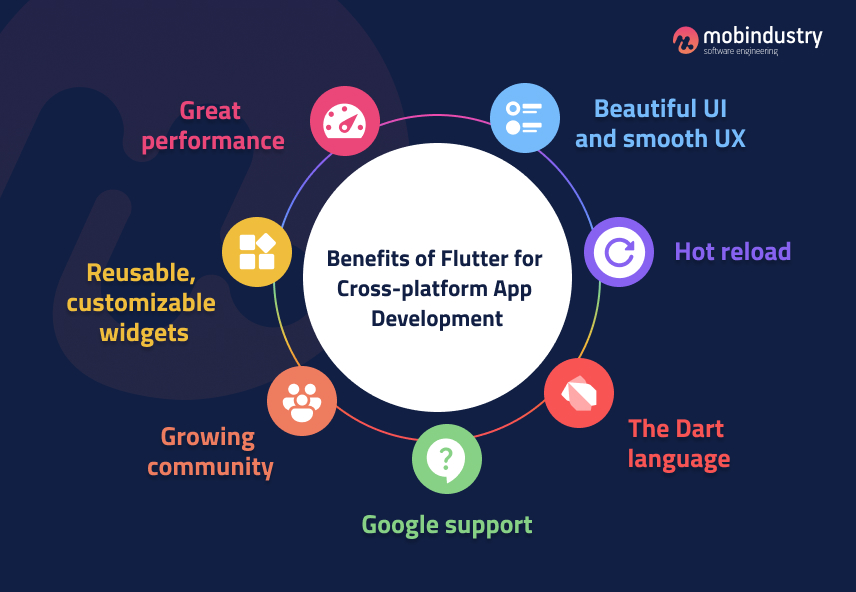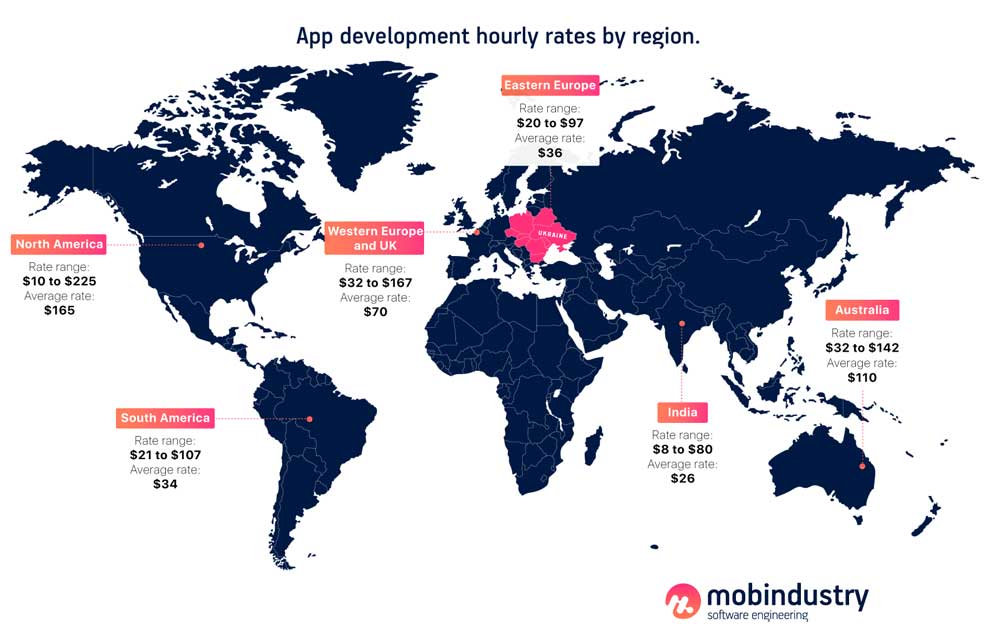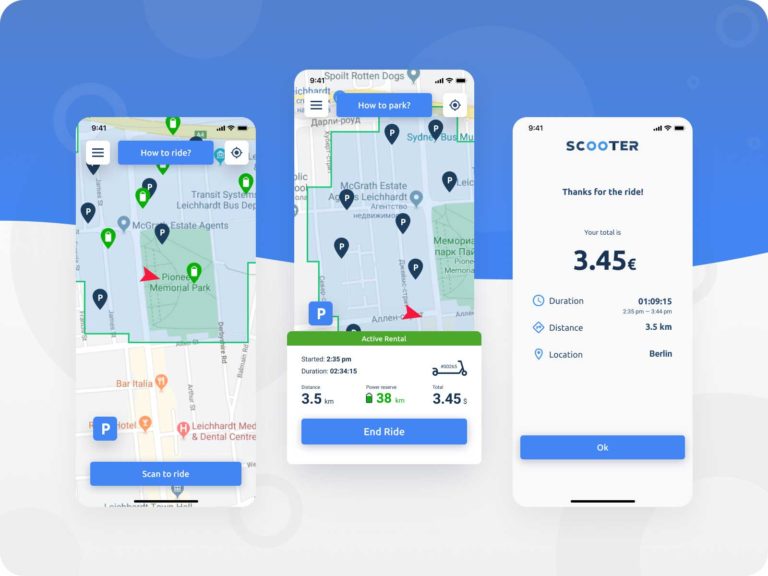How Much Does It Cost to Build a Flutter app: Estimate for 2023
As cross-platform development is becoming more popular than native development, businesses look for technologies that will allow them to save money without sacrificing the quality. Flutter is a top-notch technology that is perfect for cost-effective and fast development
As cross-platform development is becoming more popular than native development, businesses look for technologies that will allow them to save money without sacrificing the quality. Flutter is a top-notch technology that is perfect for cost-effective and fast development.
What is Flutter and why choose it for your project?
Flutter is Google’s framework for cross-platform development that uses the Dart programming language. Flutter allows developers to build applications not only for Android and iOS, but also for Linux, Windows and macOS. Flutter is the most rapidly growing cross-platform technology right now, and each day more developers gain expertise in it.

Flutter documentation and community provide a fast learning curve for developers, which results in quick adoption of this technology in lots of IT companies across the world.
Why choose Flutter for your project? Here are some good reasons:
- Cross-platform programming. This is of course the primary reason to choose Flutter for your project. Flutter is suitable for up to six different platforms, which makes it the most universal framework in the world.
- Great performance. Flutter’s performance is as good as that of native mobile technologies, and it makes it very different from other cross-platform technologies like React Native
- Reusable, customizable widgets. Widgets allow developers to reuse components in different parts of the app and customize them. This accelerates the development process significantly.
- Beautiful UI and smooth UX. The UI/UX principles of building Flutter apps are very close to those of native applications.
- Growing community. Community plays a huge role in adopting and learning the framework and the programming language, and it also helps to expand the Flutter possibilities. Developers add new solutions that the rest of the community can benefit from, and this makes Flutter suitable for more and more complex applications.
- Google support. Google invests into Flutter and plans to make it their primary technology. Google support means outstanding documentation and quick issue resolution.
- Hot reload. Hot reload is a feature that allows developers and quality assurance specialists to develop and test their applications faster and save money for the clients. Hot reload lets developers to immediately see the changes they made to the code without having to wait to reload an app.
- The Dart language. The programming language Dart that’s used in Flutter, has a clean syntax that allows developers to build great architectures. Dart increases collaboration among developers who benefit from common standards, and is easy to learn by programmers who have experience with C#, TypeScript and Java. Dart is also easy to maintain and test.
Overall, Flutter is a very flexible, multiplatform technology that allows developers to build beautiful and high-performance applications for both Android and iOS from a single code base.
When should you choose Flutter? Flutter is perfect for small and mid-sized projects that don’t require complex integrations and technologies, though each year new capabilities are added to Flutter. I believe that soon it will be as powerful as native technologies, and it’s definitely Google’s plan as well.
Are there any drawbacks in Flutter? There’s nothing perfect in the world, so Flutter also has its restrictions. Let’s talk about them too.
- Flutter isn’t the best option to build apps for WearOS and Android TV. Many of Flutter’s features aren’t supported by these two platforms, and though it’s possible to build a Flutter app for WearOS or Android TV, the technical restrictions may lead to issues during the development and increased costs.
- Limited number of libraries. Compared to other cross-platform frameworks like React Native or Xamarin, Flutter has fewer libraries for different functionality. This makes it difficult to develop some specific features, but as the community grows, Flutter offers more and more libraries to developers.
- Weaker iOS support. Because Flutter is made by Google, it doesn’t support all the iOS features like VoiceOver, Guided Access, Captioning, and Audio Description. However, this also may change soon.
Most businesses choose Flutter because it’s a cross-platform technology. But how much money exactly can you save by developing your app with Flutter? Let’s discuss the average cost of Flutter app development services and compare it to other technologies. But first, we’ll discuss the factors that influence the Flutter app development cost in 2022.
What influences the cost of developing a Flutter app
There are many factors that determine the cost of developing an application with Flutter, just like with any other technology. Let’s review them.
Application size and complexity
The bigger the app, the more time it takes to develop, test and release it. All applications are categorized into “low”, “medium” and “high” depending on the number and complexity of their features. Complex applications require not only more development time, but also more time and effort for preparation.
Developers also need to spend more time on architecture and on development of each individual feature. Features like login don’t take much time, but if you plan to implement video conferencing or chats in your Flutter app, it will be expensive. Features connected with AR and machine learning require even more time.
App design
Application design is another factor that can significantly influence the final cost to develop a Flutter app. Usually it doesn’t take too long to develop a basic design for an application, however, basic design doesn’t cut it in most cases. Businesses try to make their applications look unique to be different from competitors, and also have some engaging elements so their users spend more time in the app.
App design can take up to 20% of the whole development budget, if it’s complex and has animations and interactive elements. These elements are especially important for fitness, wellness, sleep, e-learning and gaming applications.
Testing and maintenance
You’ll need to continue investing in your application even after it’s released. Regular testing, security checks, operating system updates, library updates, fixes, new versions of the programming languages is all you need to constantly take care about.
Think about these expenses before the development starts, and plan your budget accordingly. Applications that aren’t supported and maintained quickly lose relevance and users, and without proper care all your initial investments will be lost.
Typical yearly maintenance costs take 15% to 45% of the initial budget of the app, depending on how large your application is, and how often you add new features and update it.
Developer’s location
The location of your development team is by far the most influential factor that determines the Flutter app cost along with its size and functionality. Depending on the location of developers, the Flutter app development cost can differ drastically, up to 5x.

Eastern European countries like Ukraine typically have lower rates for Flutter development compared to western European countries, the UK, and the US, while also offering the same or even higher code quality.
The average hourly rate of Ukrainian Flutter developers is $30-65 depending on their experience. The average hourly rate of Flutter developers in the US is $75-120. As you can see, the difference is drastic. Multiply it by the number of hours that your project will take to develop, and you’ll get two completely different budgets.
Let’s look at the average hourly rates of developers in different countries and regions.
| Region | Average hourly rate (in US dollars) |
| The USA and North America | $75 – 120 |
| Western Europe | $70 – 90 |
| Eastern Europe, Ukraine | $30 – 65 |
| Brazil and Latin America | $40 – 60 |
| India | $20 – 40 |
On average, the Flutter developer salary in the USA is $115,000, while in Ukraine the developer with the same skills will earn on average $36,000 a year.
The developer’s hourly rate isn’t the only thing you’ll need to consider when calculating the final cost of your Flutter development project. There are some additional costs not many people think about when planning to develop a Flutter app.
Additional costs
When estimating the cost of developing an app, don’t forget about the additional costs. They include:
- Releasing an app to the app markets
Google Play and App Store both charge fees for developer’s accounts you need to release an application. Moreover, it takes additional time for developers to prepare the application for the publication due to policies and requirements of app markets.
- App security
Making an application secure is a separate activity that also takes time and additional resources like security tools for encryption.
- Hosting and servers
Your backend requires servers for data storage and processing. Depending on your strategy, you’ll either need to purchase a physical server and maintain it yourself, or pay regularly for a BaaS (backend-as-a-service) solution. Storage fees aren’t your only expenses: data requests, storage management and data transfers may be associated with additional costs.
- Third-party services
Third-party services like maps, payment gateways and libraries are often paid. For example, PayPal charges you for each transaction, and Google Maps – for a number of requests from your users.
There are other additional costs associated with mobile app development like software licensing, and they can take up a significant amount of budget. I recommend you to consult with your vendor to find out how much you’ll need to add to your expenses.
Because there are so many factors that influence the cost, it’s almost impossible to name the price for a Flutter application without knowing anything about it. However, I’ll try to provide you with some numbers based on average app size and number of hours it usually takes to build an application.
How much does Flutter app development cost?
Let’s talk about the average application sizes and how much money it may cost to develop each type of application, from small to large.
A small application takes on average 2 months to be developed. This is also true for MVPs that you plan to expand later after the release. Such an application will have basic features and design, but it will be enough to test your idea on the market and decide on further steps.
A mid-sized app takes 3 – 4 months to be developed. You can hire additional developers to accelerate the development process, but the number of hours and the cost of a project will stay the same.
A large application takes 4 – 6 months of development, and can take even more, depending on the number and complexity of the functionality. The development time also depends on how well the application was thought out, and how fast the decisions are made.
Let’s say you hired a development team from Ukraine at a rate of $35 per hour, you’ll get these costs:
| Project size | Development hours | Cost |
| Small | 320 | $11,200 |
| Mid-sized | 480 – 640 | $16,800 – $22,400 |
| Large | 640 – 960 | $22,400 – $33,600 |
Note that these numbers only include the work of developers. You need to consider all the factors I mentioned above, and also note that you’ll need to add the work of other specialists. A project manager will be able to provide you with a full cost breakdown after the planning stage of your project that we call the discovery phase.
A typical Flutter development team consists of:
- Flutter developer
- Quality assurance specialist
- Project manager
- Business analyst
- UI/UX designer
… and other specialists like that will work on your project.
Here is the average cost of Flutter app depending on its type:
- A simple application with basic features such as a fitness app without complex design will cost approximately $25,000 – $35,000 with all additional costs.
- A mid-sized application with more complex features such as voice calls, will cost $37,000 – $49,000.
- A large application with complex features like a social media app will cost you $35,000 – $60,000 and more.
Compare these prices with native app development: if you want your native app to be available on both Android and iOS, you can just multiply the numbers I mentioned above to approximately 1.75, as you’ll need to develop two separate applications for each platform.
Flutter development is significantly more cost effective than native development, and though it doesn’t yet have all the capabilities of native technologies, this will soon change because of the rapid development and community contributions.
How Mobindustry can help you with Flutter development
Mobindustry was one of the first companies to adopt Flutter. All our developers who previously worked with native technologies, learned Flutter quickly because of their previous experience with native languages. As Flutter’s popularity and maturity increased, more of our new clients chose it as their preferred technology.
Currently we already have over 10 completed projects developed with Flutter, from logistics applications to scooter sharing and food delivery apps.
If you want to develop an application with Flutter, and you’re not sure how much it will cost, or what steps you need to take, simply contact us. We’ll consult you on the technology stack and further steps based on your business needs, requirements and budget.
Mobindustry is situated in Ukraine, so you’ll benefit from lower rates compared to the US, while getting an amazing quality of code and communication. These are the common steps of Flutter app development at Mobindustry:
- Initial consultation and a rough estimate – we talk with you about your app idea and business goals you’d like to achieve, and tell how much such an application might cost based on our previous development experience
- Discovery phase — a business analyst extracts requirements for your future application and creates a technical specification — a document that describes each feature of your future application, its business logic, technologies, both functional and non-functional requirements and people responsible for the delivery. At this stage you can also involve a designer who will create both UI and UX design for your future app.
- Developers’ and project manager’s final estimate — the lead developer reviews the technical specification and estimates the time needed for each feature. Then, a project manager finalized that estimate by counting in the time for communication and risks.
- Architecture setup — developers prepare the environment for future development and build an architecture with all the requirements in mind
- Development and testing — the quality assurance process happens almost simultaneously with the development: each new part of the code is immediately tested, so that there are fewer errors in the end build.
- Final testing and release to app markets — developers prepare the application for the release, considering all the rules and requirements of the application markets, and release an application.
- Maintenance, support and development of new features — developers create new features based on your business needs, and regularly check the code, update libraries and third-party services, and adapt your app for the new versions of the operating systems.
This is how the process of building a Flutter application looks like at Mobindustry. We make sure the app is useful for your business at each stage of planning and development, and also provide our clients with marketing advice. We also help to set up and track the analytics, so you know how the market reacts to your application, and which features are the most important for your users.
If you want to build a Flutter app for your business, don’t hesitate to contact us.


